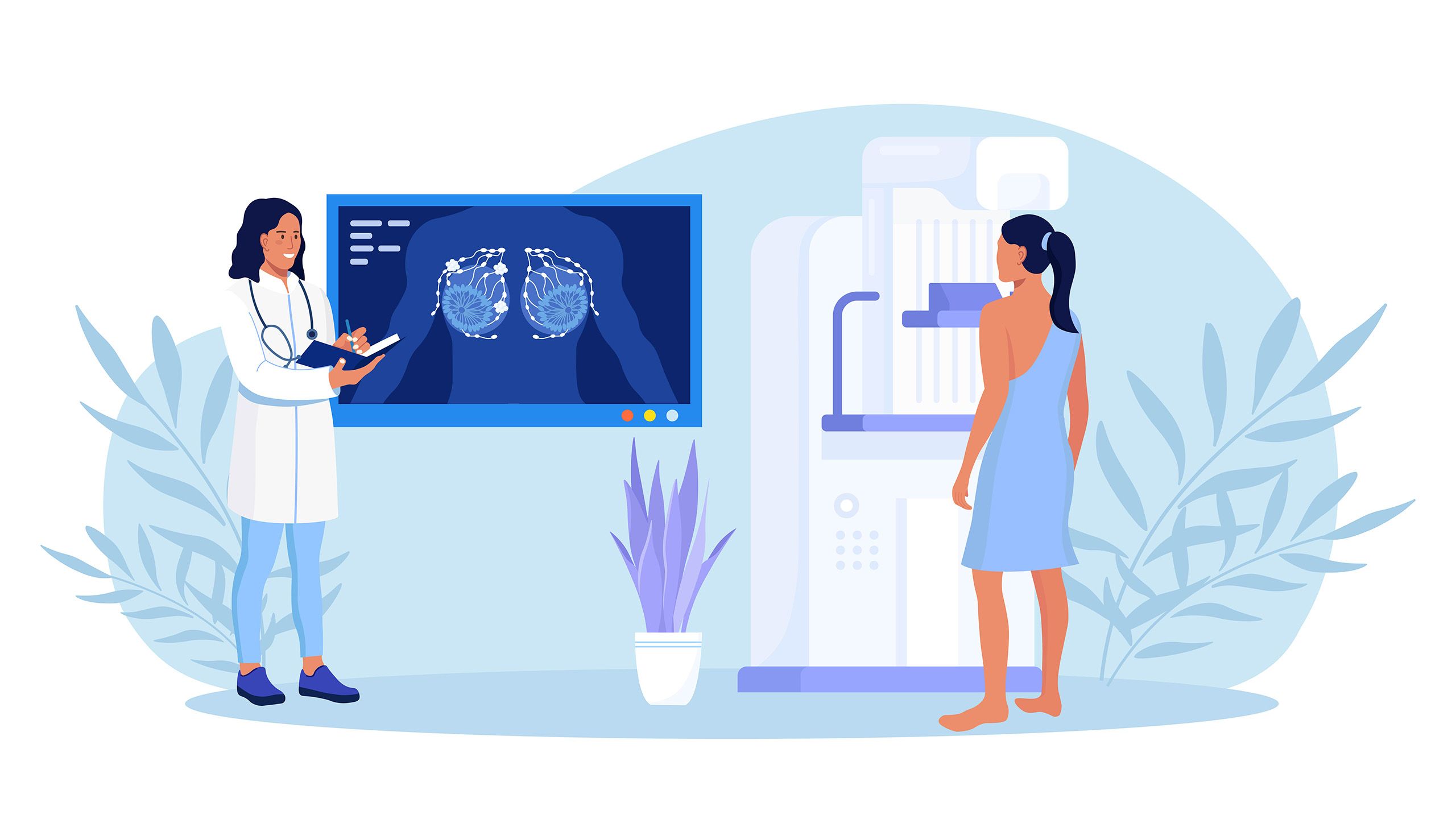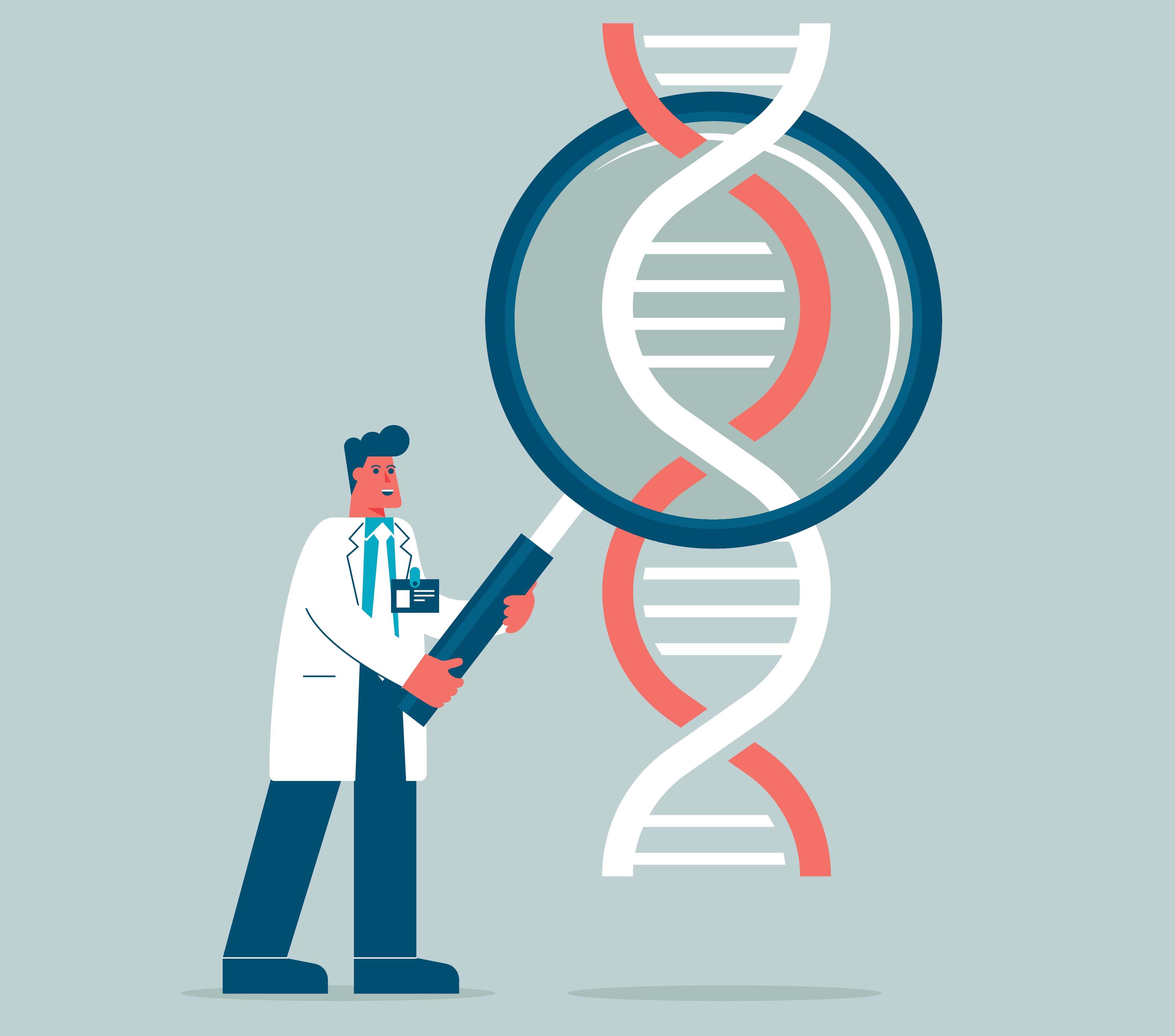Back to BRCA
How the discovery of a breast cancer risk gene changed the story of cancer

In 1994, a landmark paper identified a gene – BRCA1 – that significantly increases the risk of breast and ovarian cancers when faulty. Thirty years on, we look at the major impact it has had on how we understand and treat cancer – and why there is still much to learn.
On 7 October 1994, the journal Science published an article that would not only transform our understanding of how cancers arise, but would lead to treatments that would save hundreds of thousands of lives worldwide.
In the article, a team of US scientists led by Professor Mark Skolnick identified a gene known as BRCA1, which was faulty in a number of families with hereditary breast and ovarian cancers.
Although pipped to the post in the race to discover the gene, Cambridge researchers – in particular Professors Bruce Ponder and Doug Easton – played a huge role in the work that underpinned this discovery, identifying families with a history of breast cancer and narrowing the search down to a small region on chromosome 17.
Professor Doug Easton
Professor Doug Easton
Just over a year after the discovery of BRCA1, Ponder and Easton would be among the authors on an article in Nature that identified a second gene, BRCA2, which could also cause hereditary breast cancer when faulty. Easton and co-author Professor Mike Stratton from the Institute of Cancer Research had led work that narrowed the search for this gene down to chromosome 13, resulting in its subsequent discovery.
What is a gene?
A gene is a section of your DNA that contains the instructions for building proteins, molecules that perform many critical functions in your body. Genes get passed down from parents to their children.
A gene is written in ‘code’ made up of a collection of units of DNA, represented by A, T, C and G. Sometimes, genetic variants contain small changes in their ‘code’ – an A instead of a T, for example – that subtly or fundamentally change how the gene functions.

Finding disease-causing genes was not new. They had already been identified for conditions such as cystic fibrosis, where a single faulty gene causes the disease. But searching for genes for more common, complex diseases, where multiple genes contribute to disease risk, had not been tried before.
“It was an open question whether you could do the same for a common disease like cancer,” says Easton, now Professor of Genetic Epidemiology and Director of the Centre for Cancer Epidemiology at Cambridge. “Now, it seems obvious, but it definitely wasn't at the time. People were quite sceptical.”
Professor Helena Earl
Professor Helena Earl
Helena Earl, Professor Emeritus in Clinical Cancer Medicine at Cambridge, was a senior lecturer and consultant at the University of Birmingham in 1994, where she treated many women with breast and ovarian cancer. She recalls their local clinical geneticist being “extremely excited” by the discovery. But looking back, she says, “the discovery of the BRCA genes was just the beginning of the story.”
Finding the carriers
The discovery of the two BRCA genes had one obvious, immediate implication. As Easton says, “You could suddenly identify people who were at much higher risk than the rest of the population.”
Cambridge was one of the many places to capitalise on the discovery, establishing a clinical genetic centre to test women for the genes. This allowed clinicians to identify and counsel women at high risk, leading to new approaches such as MRI screening, which are now routine for carriers of high-risk genetic variants.
"It was really transformational, and quite quickly."
Professor Doug Easton
Earl recalls: “I remember seeing a young woman who had stage 4 ovarian cancer. Nobody in her family had had ovarian cancer, which was puzzling, but we tested her and she was BRCA1 positive. The gene had come from her father.”
Professor Jean Abraham
Professor Jean Abraham
Professor Jean Abraham was still at medical school when the news of BRCA1 broke. Now Director of the Precision Breast Cancer Institute and a consultant oncologist at Cambridge University Hospitals, she says: “I was fascinated to read about it, but if I'm honest, I'm not really sure I fully understood what the impact of that finding would be.”
Today in her clinic, Abraham sees patients with breast cancer or who are at high risk. Working out whether they are BRCA1 or BRCA2 carriers can be vital to providing the most appropriate treatment. But the impact on the patient cannot be underestimated, she says.
“A hereditary cancer is an awful burden because you have the cancer yourself, and then if you have children, you have that extra burden of realising you might have given that same risk to them. It's a big burden for patients to cope with psychologically, as well as physically.”
A complicated picture
The discovery of the genes energised the discipline of genetic epidemiology of common cancers, says Easton – “the idea that if you collect the right sort of data and you have the technology, you can really discover a lot about the genetics of a disease.”
Professor Antonis Antoniou
Professor Antonis Antoniou
Working alongside Easton at the Centre for Cancer Epidemiology at Cambridge is Antonis Antoniou, now Professor of Cancer Risk Prediction and Director of Cancer Research UK’s Cancer Data Driven Detection initiative. In 1994, Antoniou was studying actuarial science – the mathematics of insurance – at the London School of Economics. He says there was much interest within the insurance sector about how to take into account information about an individual’s genetic risk (though there is now a moratorium on using this information). He describes the discovery of the BRCA genes as a ‘milestone’.
“We were able for the first time to identify those with substantially increased risk of developing breast or ovarian cancer and then help them, together with their healthcare professionals, make informed decisions about managing their cancer risks, for example through risk mitigation surgery, increased surveillance, starting screening at a younger age, and so on.”
In 2003, Antoniou, under the guidance of Easton, led a landmark study using family data on relatives of BRCA1 and BRCA2 carriers, that provided the first reliable estimate for the risks of breast and ovarian cancer associated with the genes.
He followed this up in 2017 with the first large-scale multinational prospective study of cancer risks for female BRCA1 and BRCA2 carriers, demonstrating that an individual carrier’s risk also depended on where exactly in the gene the mutation occurred and their family history of cancer. This highlights some of the complexities of genetics.
“You might think after 20 years we’d know everything about [BRCA1 and BRCA2],” says Easton, “but one of the things we don't know completely is which variants in the gene are associated with cancer.”
The variants Easton and colleagues found in the original families make the gene inactive, but there are many other, so-called ‘missense variants’, where just one amino acid is changed.
"Some of [the variants] are risk associated and some are not, and that's a real headache for the for the clinicians. We still don't know for sure how to classify them all."
Professor Doug Easton
And while BRCA1 and BRCA2 are very important, they only explain around a fifth of familial breast cancer cases.
“It became clear [the discovery of these genes] was by no means the whole story,” says Easton. “The next question was, what explains the rest?”
As technology has progressed, large-scale studies – often involving tens or even hundreds of thousands of patients – have revealed a large number of common variants which, individually, are much less important than the BRCA genes, but still add together to increase an individual’s risk.
“Another related question is how these variants and genes relate to each other and to other risk factors,” says Easton. “What are the lifestyle factors that influence the risks? And how do you put all these risks together?”
Easton and Antoniou have led several major studies that have sought to address these questions, showing that common genetic variants, and other lifestyle factors, modify cancer risks for BRCA1 and BRCA2 carriers, acting like a ‘volume control’ that amplify or reduce cancer risks for carriers. Their work has led to CanRisk, an online tool that enables healthcare professionals to calculate an individual's risks of developing breast and ovarian cancer using family history, genetic and various other lifestyle, hormonal and reproductive risk factors (it will soon expand to include prostate cancer). The tool is used in clinical practice from the UK and Europe to the US and Australia and has provided more than 3.2 million risk assessments in the past four years.
Exploiting BRCA’s Achilles’ heel
In the early 1990s, Steve Jackson – now a Professor and, as of 2023, a Knight Bachelor – had set up a lab to look at transcription, the process by which our DNA gets converted to RNA in order to make proteins (akin to reading a recipe in order to make a dish).
Professor Sir Steve Jackson
Professor Sir Steve Jackson
In 1994, around the time that the first BRCA gene was discovered, Jackson published a paper in Science on DNA repair – the mechanism for mending damaged DNA.
When Jackson read about the discovery of BRCA1, he remembers thinking “Oh, isn't that cool?” but at that time there was no suggestion that the gene was linked to DNA repair – it would take until the late 1990s before the picture became clearer.
It transpired that the BRCA genes caused a fault in one of the two main mechanisms for repairing DNA double-strand breaks. Jackson realised this was a weakness that could be exploited to kill tumours. Over the following years, through his spinout company KuDOS, set up with the support of Cancer Research UK and later bought by AstraZeneca, he developed a new class of cancer drug known as PARP inhibitors – the first of these, olaparib, has since been used to treat over 140,000 patients globally.
“As a molecular biologist,” Jackson says, “[the discovery of the BRCA genes] was very exciting. It showed that if you understand the molecular basis of cancers, it might help you understand and come up with better ways of treating them.”
Abraham says the discovery of the BRCA genes “paved the way for a revolution in targeted care”. She is involved in developing clinical trials that build on Jackson’s work, for example looking at treatments for patients who have a non-hereditary breast cancer, but one that has some biological similarities to breast cancer in BRCA carriers.
“My role, if you like, is both to develop better ways to treat [BRCA carriers], but to also understand the differences between these patients and other patients who are similar but not the same, and in doing so find better ways to treat all of those patients.”
Sometimes, she says, it is about understanding how much treatment they need. “We often give patients a lot of treatment because we want them to respond and not get the disease back. So, can we scale it down for different types of breast cancers?”
Redefining cancers
If you know only one thing about the BRCA genes, it is probably that they are breast cancer susceptibility genes – indeed, the name itself stands for BReast CAncer gene. But from the outset, it was known that BRCA1 increases the risk of ovarian cancer, too. As scientists get a better understanding of these genes, it’s becoming clear that they play a role in many other cancers.
“We know that BRCA1 is primarily associated with breast and ovarian cancer,” says Easton. “BRCA2 has a somewhat wider range – it’s got quite a significant association with prostate cancer and also pancreatic cancer. But there may be other cancers involved.”
In recent years, this has led to a fundamental shift in how we look at cancers, says Jackson.
“Whereas in the past people would categorise cancers based on where they arose and the cell types they came from, we're now into this molecular classification of cancers."
Professor Sir Steve Jackson
"It doesn't matter that it's a prostate cancer, if it's got a BRCA mutation, you should be thinking about treating it with the same types of drugs you're using in BRCA-mutated breast and ovarian cancers."
Just the beginning
Besides the obvious implications that the discovery of BRCA1 and BRCA2 has had in terms of understand and treating cancer, there have also been wider benefits, say the researchers.
“It's helped fundraising organisations such as Cancer Research UK to get their message over to the public,” says Jackson. “These are things that people can connect to, particularly when you get certain very well-known individuals such as Angelina Jolie stepping in front of the media and saying, ‘I've got a BRCA mutation’.”
Abraham points to the boost that the discovery has had to the scientific community. “There are literally thousands of people whose entire careers have been spent either looking in more detail at these genes or quantifying and understanding the risks that these genes pose."
"It’s expanded way beyond where it started and has had an amazing impact both in terms of the development of treatments and in terms of the research community."
Professor Jean Abraham
Jackson agrees. “It’s been a great example of cooperative research. It’s not just the fundamental scientists, it's the epidemiologists, it’s the pharmaceutical companies, it's the biotech companies and the patients themselves. Of course, there were some skirmishes along the way, but it's been a global effort, and one that the UK has played a major role in. It’s a great showcase for what we can achieve.”
Despite the incredible progress that has been made over the past thirty years – and the many thousands of lives that have been saved – one thing is clear: we do not yet have all the answers.
“The discovery of the BRCA genes is an extraordinary story,” says Earl, “but it's still not finished. There's lots still to learn.”
Support cancer research at Cambridge
Cambridge hosts a cancer research community responsible for globally significant breakthroughs and innovations.
Together we are changing the way cancer is treated. Our scientists will make discoveries alongside expert clinicians treating patients, drawing on the world-leading expertise found within the University and across the Cambridge Biomedical Campus.
We will find cancer earlier and treat it better. Join us.

Published on 7 October 2024
Illustrations
- Woman getting a breast screening test (Nadezhda Buravleva)
- Scientist examining DNA with a magnifying glass (sorbetto)
The text in this work is licensed under a Creative Commons Attribution-NonCommercial-ShareAlike 4.0 International License









